King M.R., Mody N.A. Numerical and Statistical Methods for Bioengineering: Applications in MATLAB
Подождите немного. Документ загружается.


% Compute model
x = 1:.1:length(data);
y = p(3)/sqrt(2*pi*p(2)^2)* ...
exp(-(x - p(1)).^2/(2*p(2)^2)) + p (4);
% Compare data with the Gaussian model
figure(i)
plot(data(:,1),data(:,2),‘ko’,x,y,’k-’)
xlabel(‘{\itx}’, ‘FontSize’,24)
ylabel(‘Intensity’, ‘FontSize’,24)
set(gca, ‘LineWidth’,2, ‘FontSize’,20)
end
MATLAB program 8.15
function SSE = PixelSSE(p)
% Calculates the SSE between the observed pixel intensity and the
% Gaussian function
% f = a1/sqrt(2*pi)/sig*exp(-(x-mu)^2/(2*sig^2)) + a2
global data
% model parameters
mu = p(1); % mean
sig = p(2); % standard deviation
a1 = p(3); % rescales the distribution
a2 = p(4); % baseline
SSE = sum((data(:,2) - a1./sqrt(2*pi)./sig.* ...
exp(-(data(:,1) - mu). ^2/(2*sig.^2)) - a2).^2);
Note the use of string variables (and string concatenation) to generate filenames; together with the
load function this is used to automatically analyze an entire directory of up to 999 input files. Also,
this program provides an example of the use of the global declaration to pass a data file between a
function and the main program. Figure 8.15 shows the good fits that were obtained using Program 8.14
to analyze four representative data files.
This program works well, and reliably finds a best-fit Gaussian model, but what happens when the
cell synapse begins to separate and show a distinct bimodal appearance such as shown in Figure 8.16?
It seems more appropriate to fit data such as this to a function comprising two Gaussian distributions,
rather than a single Gaussian. The following function is defined:
fðxÞ¼a
1
1
ffiffiffiffiffiffiffiffi
2πσ
2
p
exp
x μ
1
ðÞ
2
2σ
2
!
þ
1
ffiffiffiffiffiffiffiffi
2πσ
2
p
exp
x μ
2
ðÞ
2
2σ
2
! !
þ a
2
:
Figure 8.15
Observed pixel intensities at four cell synapses and the fitted Gaussian models
0 10 20 30 40
80
100
120
140
160
x
Intensity
0 10 20 30 40
100
120
140
160
180
x
Intensity
0 10 20 30 40
100
150
200
250
x
Intensity
0 10 20 30
100
120
140
160
x
Intensity
517
8.3 Unconstrained multivariable optimization
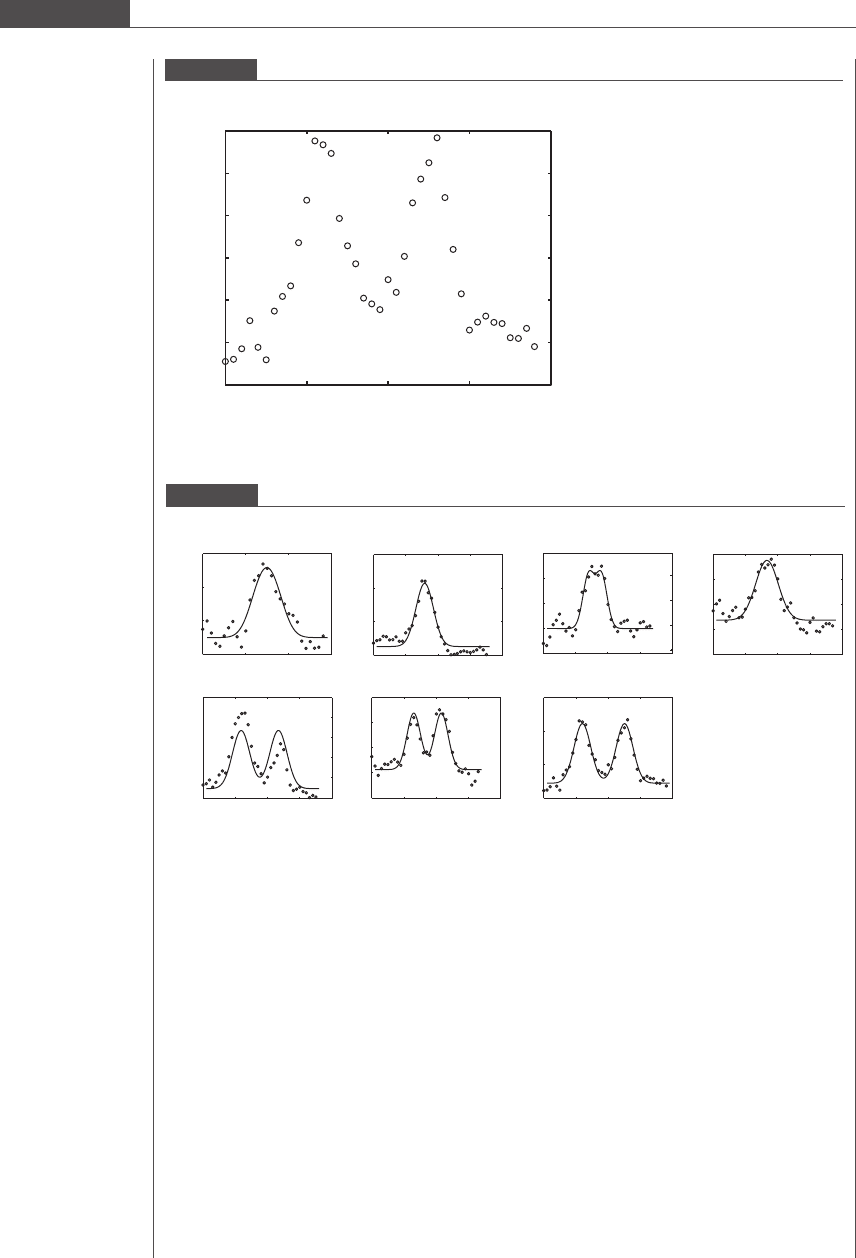
Note that we have reduced the degrees of freedom by making the two Gaussian curves share the same
scaling factor a
1
and the same σ; the rationale for this restriction is discussed below. It is desirable that the
new bimodal analysis program be robust enough to converge on both unimodal and bimodal data sets, to
avoid the need to check each curve visually and make a (potentially subjective) human decision on each
data set ... as this would defeat the purpose of our file input commands capable of analyzing up to 999
files in one keystroke! The improved, bimodal algorithm is implemented in Programs 8.16 and 8.17 given
below. The relevant metric to characterize the width of the bimodal curve is now μ
1
μ
2
jj
added to some
multiple of σ. As shown in Figure 8.17, Program 8.16 reliably fits both unimodal and bimodal pixel
intensity curves.
The images in the first row of Figure 8.17 show the apparently unimodal images that were previously
analyzed using Program 8.15, and those in the second row show obviously bimodal images; Program
8.17 can efficiently characterize both types. Interestingly, initially the third image appeared unimodal,
but upon closer inspection we see a dip in the middle of the pixel range that the bimodal regression
algorithm correctly detects as nearly (but not exactly) overlapping Gaussians. It was determined that if
additional parameters are added to the model: (i) two, distinct values for σ, or (ii) individual scaling
factors for each peak, then the least-squares regression will attempt to create an artificially low, or wide,
peak, or a peak that is outside of the pixel range, in an attempt to deal with an uneven baseline at the two
edges of the data range.
Figure 8.16
Pixel intensities exhibited by separating cell synapse
0 10 20 30 40
100
120
140
160
180
200
220
x
Intensity
Figure 8.17
Observed pixel intensities at seven cell synapses and the fitted bimodal Gaussian models
100
150
200
250
Intensity
100
120
140
160
180
Intensity
0 10 20 30 40
80
100
120
140
160
x
Intensity
0 10 20 30 40
100
120
140
160
180
x
Intensity
0 10 20 30 40
100
150
200
250
x
Intensity
0 10 20 30
100
120
140
160
x
Intensity
140
160
180
200
220
240
Intensity
010203040
x
010203040
x
01020 3040
x
518
Nonlinear model regression and optimization

MATLAB program 8.16
% This program uses fminsearch to minimize the error of nonlinear
% least-squares regression of the bimodal Gaussian model to the pixel
% intensities data at a cell synapse
% To execute this program place the data files into the same directory in
% which this m-file is located.
% Variables
global data % matrix containing pixel intensity data
Nfiles = 7; % number of data files to be analyzed, maximum allowed is 999
for i = 1:Nfiles
num = num2str(i);
if length(num) == 1
filename=[‘data00’,num,’.dat’];
elseif length(num) == 2
filename = [ ‘ data0’,num,’.dat’];
else
filename = [ ‘ data’,num,’.dat’];
end
data = load(filename);
p = fminsearch(‘PixelSSE2’,[10,25,5,220,150]);
% Compute model
x = 1:.1:length(data);
y = p(4).* ...
(1/sqrt(2*pi*p(3).^2)*exp(-(x - p(1)).^2/(2*p(3).^2)) + ...
1/sqrt(2*pi*p(3).^2)*exp(-(x - p(2)).^2/(2*p(3).^2))) + p(5);
% Compare observations with the Gaussian model
figure(i)
plot(data(:,1),data(:,2),‘ko’,x,y,’k-’)
xlabel(‘[\itx]’, ‘FontSize’,24)
ylabel(‘Intensity’, ‘FontSize’,24)
set(gca, ‘LineWidth’,2, ‘FontSize’,20)
end
MATLAB program 8.17
function SSE = PixelSSE2(p)
% Calculates the SSE between the observed pixel intensity and the
% Gaussian function
% f = a1*(1/sqrt(2*pi*sig^2)*exp(-(x-mu1)^2/(2*sig^2))+ ...
% 1/sqrt(2*pi*sig^2)*exp(-(x-mu2)^2/(2*sig^2))) + a2
global data
% model parameters
mu1 = p(1); % mean of first peak
mu2 = p(2); % mean of second peak
519
8.3 Unconstrained multivariable optimization

sig = p(3); % standard deviation
a1 = p(4); % rescales the distribution
a2 = p(5); % baseline
SSE = sum((data(:,2)-a1.* ...
(1/sqrt(2*pi*sig.^2)*exp(-(data(:,1)-mu1). ^2/(2*sig.^2))+ ...
1/sqrt(2*pi*sig.^2)*exp(-(data(:,1)-mu2).^2/(2*sig.^2)))-a2).^2);
Box 8.4A Kidney functioning in human leptin metabolism
The rate of leptin uptake by the kidney was modeled using Michaelis–Menten kinetics in Box 3.9A in
Chapter 3:
R ¼
dS
dt
¼
R
max
S
K
m
þ S
:
In Box 3.9A, the rate equation was linearized to obtain the Lineweaver–Burk equation. Linear least-
squares regression was used to estimate the value of the two model parameters: R
max
and K
m
. Here, we
will use nonlinear regression to obtain estimates of the model parameters.
The best-fit parameters obtained from the linear regression analysis are used as the initial guessed
values for the nonlinear minimization problem:
K
m
¼ 10:87; R
max
¼ 1:732:
Our goal is to minimize the sum of the squared errors (residuals). Program 8.18 calculates the sum of
the squared residuals as
SSE ¼
X
m
i¼1
y
i
^
y
i
ðÞ
2
;
where
^
y
i
¼
R
max
S
K
m
þ S
:
We use fminsearch (or the simplex algorithm) to locate the optimal values of R
max
and K
m
.
44
p = fminsearch(‘SSEleptinuptake’, [1.732, 10.87])
The fminsearch algorithm finds the best-fit values as R
max
¼ 4:194 and K
m
¼ 26:960. These
numbers are very different from the numbers obtained using the Lineweaver–Burk analysis.
We minimize again, this time using the fminunc function (line search method). Since we do not
provide a gradient function, the medium-scale optimization is chosen automatically by fminunc:
44
p2 = fminunc(’SSEleptinuptake’, [1.732, 10.87])
Warning: Gradient must be provided for trust-region method;
using line-search method instead.
Local minimum found.
Optimization completed because the size of the gradient is less than
the default value of the function tolerance.
p2 =
4.1938 26.9603
Both nonlinear search methods obtain the same minimum point of the SSE function. A plot of the data
superimposed with the kinetic model of leptin uptake fitted by (1) the line search method and (2) the
520
Nonlinear model regression and optimization
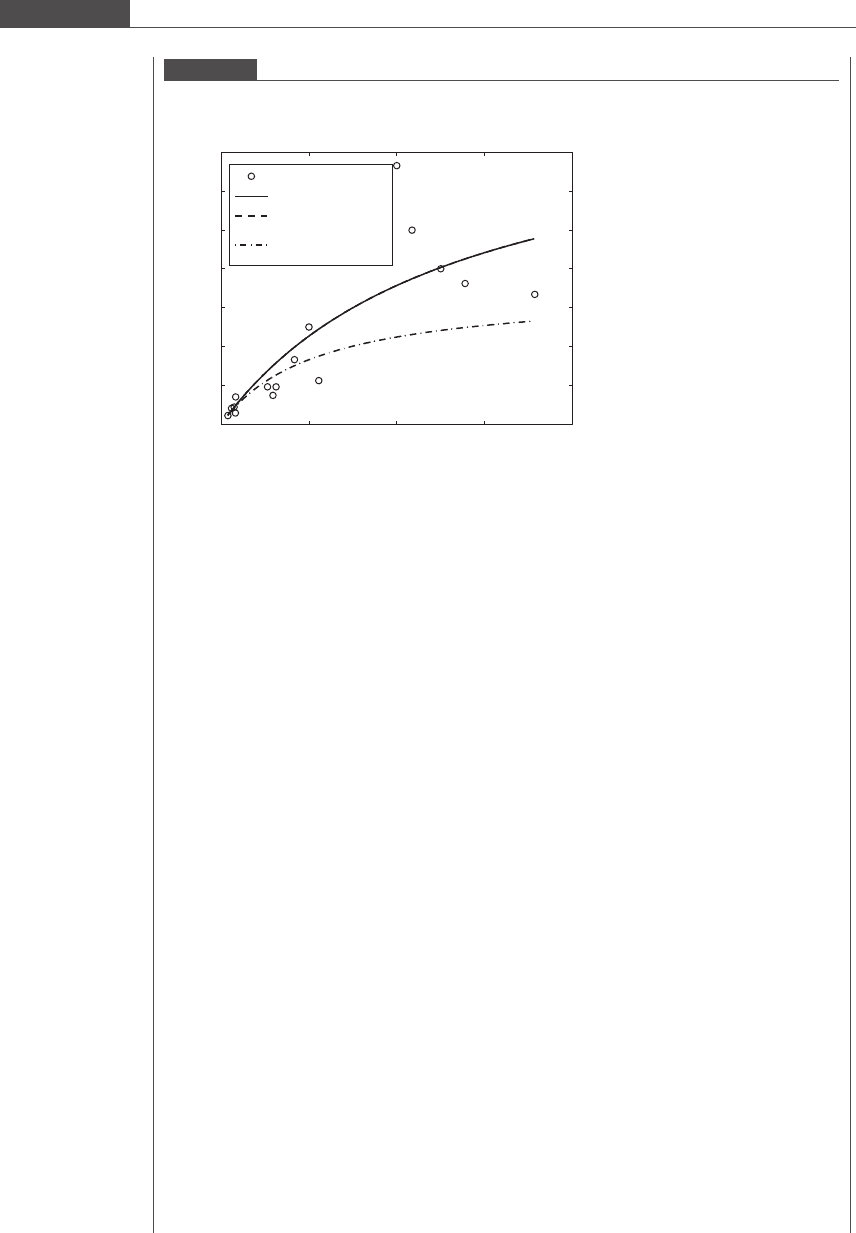
simplex method is shown in Figure 8.18. Included in this plot is the Michaelis–Menten model with
best-fit parameters obtained by linear least-squares regression. From Figure 8.18, you can see that the
fit of the model to the data when linear regression of the transformed equation is used is inferior to the
model fitted using nonlinear regression. Transformation of the nonlinear equation distorts the actual
scatter of the data points along the direction of the y-axis and produces a different set of best-fit model
parameters. In this example, the variability in the data is large, which makes it difficult to obtain
estimates of model parameters with good accuracy (small confidence intervals). For such experiments,
it is necessary to obtain many data points so that the process is well characterized.
MATLAB program 8.18
function SSE = SSEleptinuptake(p)
% Data
% Plasma leptin concentration
S = [0.75; 1.18; 1.47; 1.61; 1.64; 5.26; 5.88; 6.25; 8.33; 10.0; 11.11; ...
20.0; 21.74; 25.0; 27.77; 35.71];
% Renal Leptin Uptake
R = [0.11; 0.204; 0.22; 0.143; 0.35; 0.48; 0.37; 0.48; 0.83; 1.25; ...
0.56; 3.33; 2.5; 2.0; 1.81; 1.67];
% model variables
Rmax = p(1);
Km = p(2);
SSE = sum((R - Rmax*S./(Km + S)).^2);
MATLAB program 8.19
function SSE = SSEpharmacokineticsofAZTm(p)
global data
Figure 8.18
Observed rates of renal leptin uptake and the Michaelis–Menten kinetic model with different sets of best-fit
parameters
0 10 20 30 40
0
0.5
1
1.5
2
2.5
3
3.5
R (nmol/min)
S (n
g
/ml)
Observed data
Simplex method
Line search
Linear
transformation
521
8.3 Unconstrained multivariable optimization
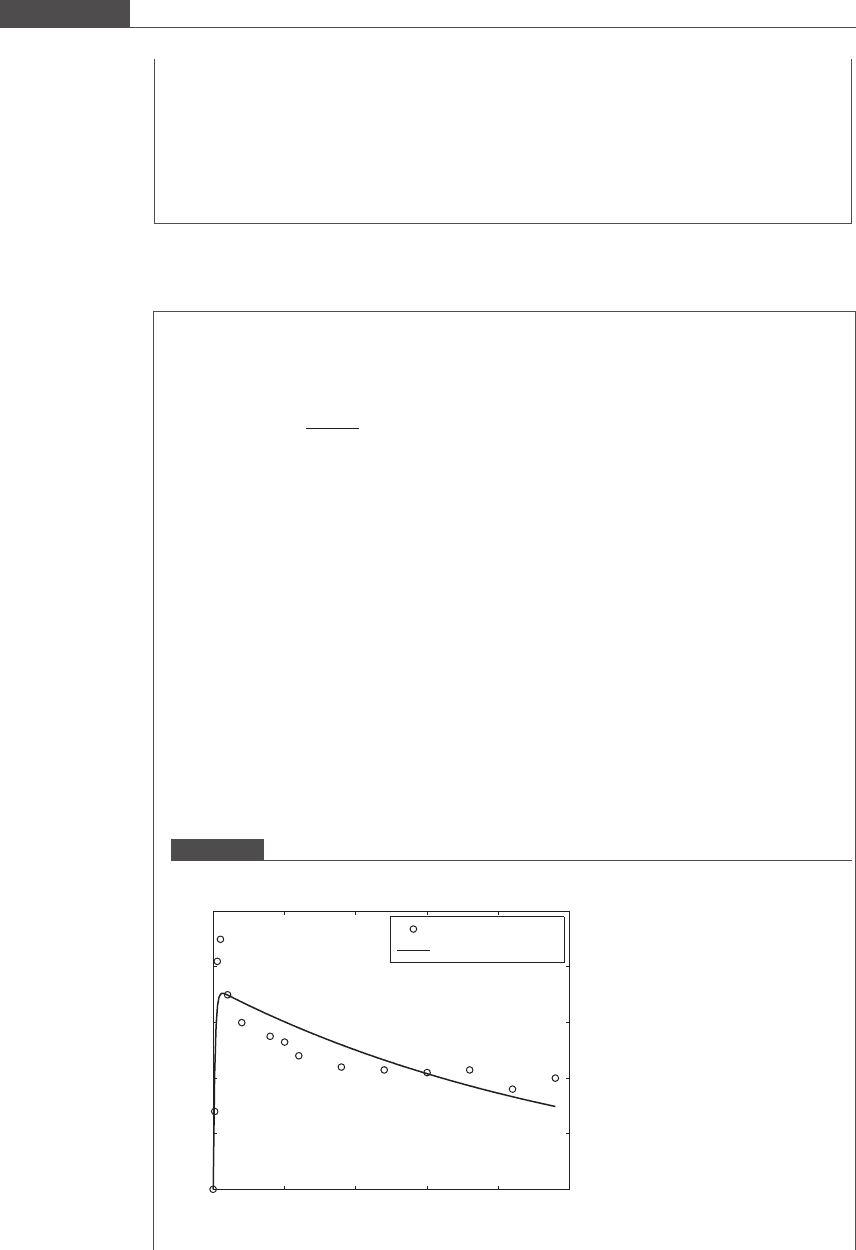
Box 8.1B Pharmacokinetic and toxicity studies of AZT
The pharmacokinetic model for the maternal compartment is given by
C
m
tðÞ¼I
m
k
m
k
m
k
e
e
k
e
t
e
k
m
t
; (8:13)
where k
m
is the absorption rate constant for the maternal compartment, and the pharmacokinetic model
for the fetal compartment is given by
C
f
tðÞ¼I
f
1 e
k
f
t
; (8:14)
where k
f
is the absorption rate constant for the fetal compartment. Nonlinear regression is performed for
each compartment using fminsearch. Program 8.19 is a function m-file that computes the SSE for
the maternal compartment model. The data can be entered into another m-file that calls
fminsearch, or can be typed into the Command Window.
% Data
global data
time = [0; 1; 3; 5; 10; 20; 40; 50; 60; 90; 120; 150; 180; 210; 240];
AZTconc = [0; 1.4; 4.1; 4.5; 3.5; 3.0; 2.75; 2.65; 2.4; 2.2; 2.15; 2.1;
2.15; 1.8; 2.0];
data = [time, AZTconc];
Figure 8.19
Drug concentration profile in maternal compartment
0 50 100 150 200 250
0
1
2
3
4
5
t (min)
C
m
(mM)
Observed values
Nonlinear model
% model variables
Im = p(1);
km = p(2); % drug absorption rate constant
ke = p(3); % drug elimination rate constant
SSE = sum((data(:,2) - Im*km/(km - ke)*(exp(-ke.*data(:,1))- ...
exp(-km. *data(:,1)))).^2);
522
Nonlinear model regression and optimization
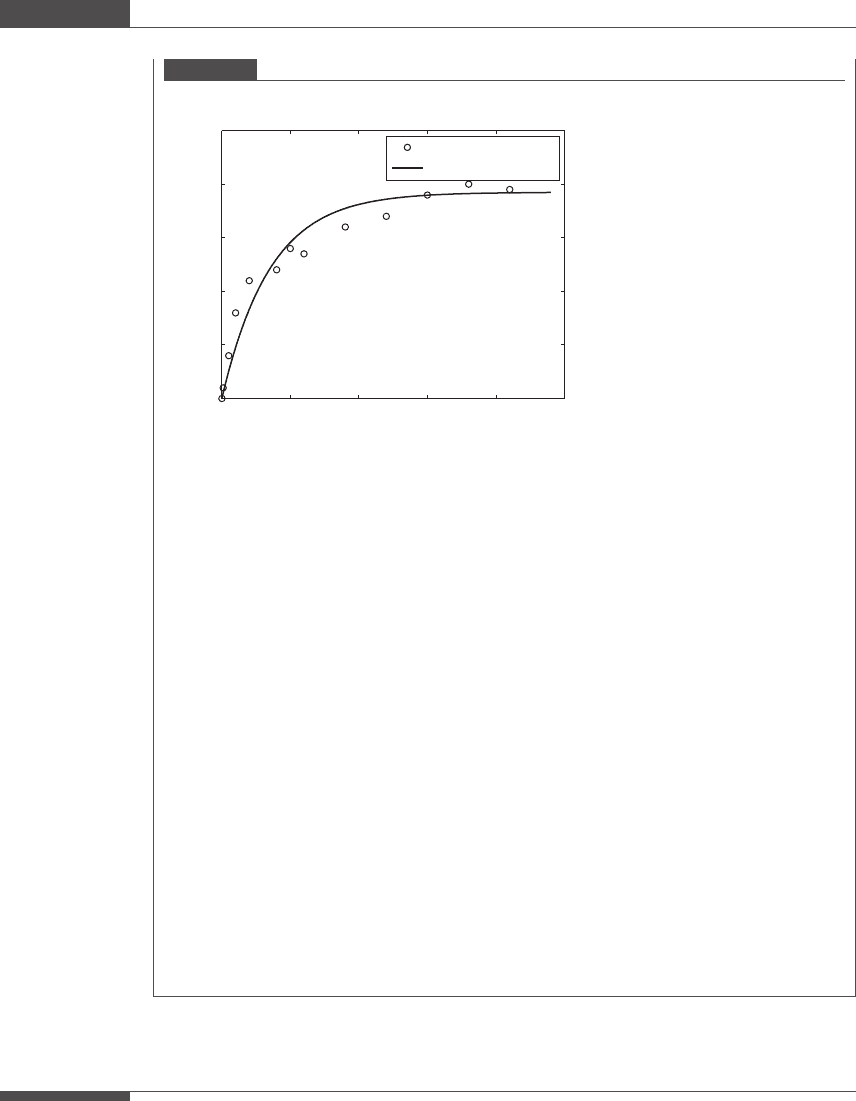
8.4 Constrained nonlinear optimization
Most optimization problems encountered in practice have constraints imposed on
the set of feasible solutions. As discussed in Section 8.1, a constraint placed on an
objective function fðxÞ can belong to one of two categories:
(1) equality constraints h
j
xðÞ¼0; j ¼ 1; 2; ...; m,and
(2) inequality constraints g
k
xðÞ0; k ¼ 1; 2; ...; p.
It is recommended that you create an m-file that loads the data into memory, calls the optimization
function, and plots the model along with the data. This m-file (pharmacokineticsofAZT.m)
is available on the book’s website.
The values of the parameters for the maternal compartment model are determined to be
I
m
¼ 4:612 mM,
k
m
¼ 0:833/min,
k
e
¼ 0:004/min.
The best-fit values for the fetal compartment model are
I
f
¼ 1:925 mM,
k
f
¼ 0:028/min.
The details of obtaining the best-fit parameters for the fetal compartment model are left as an exercise
for the reader.
Figures 8.19 and 8.20 demonstrate the fit between the models (Equations (8.13) and (8.14)) and the data.
What if we had used the first-order absorption and elimination model for the fetal compartment?
What values do you get for the model parameters?
Another way to analyze this problem is to couple the compartments such that
k
e
¼ k
f
¼ k
mf
;
where k
mf
is the rate constant for transfer of drug from the maternal to the fetal compartment. In this case
you would have two simultaneous nonlinear models to fit to the data. How would you perform the
minimization of two sums of the squared errors?
Figure 8.20
Drug concentration profile in fetal compartment
0 50 100 150 200 250
0
0.5
1
1.5
2
2.5
t (min)
C
f
(mM)
Observed values
Nonlinear model
523
8.4 Constrained nonlinear optimization

The object ive function can be subjected to either one type of constraint or a mix of
both types of constraints. Optimization pro blems can have up to m equality con-
straints, where m < n and n is the number of variables to be optimized. An equality
or inequality constraint can be further classified as follows:
(1) a linear function in two or more variables (up to n variables),
(2) a nonlinear function in two or more variables (up to n variables),
(3) an assignment function (e.g. y ¼ 10) in the case of an equality constraint, or
(4) a bounding function (e.g. y 0; z 2) in the case of an inequality constraint.
In a one-dimensional optimization problem, only inequality constraints can be
imposed. An equality constraint placed on the objective function would immediately
solve the optimization problem. An inequality constraint(s), such as x 0andx c,
where c is some constant, specifies the search interval. Minimization (or maximization)
of the objective function is performed to locate the optimum x* within the interior of
the search interval. The function is then evaluated at the computed optimum x*, and
compared to the value of the function at the interval endpoints. If the function has the
least value at an endpoint (on the boundary of the variable space) then this point is
chosen as the feasible solution; otherwise the interior optimum, x*, is the answer.
For a multidimensional variable space, several methodo logies have been devised
to solve the constrained optimization problem . When only equality constraints have
been imposed, and m, the number of equality constraints, is small, the best way to
handle the optimization problem is to use the m constraints to reduce the number
of variab les in the objective function to (n – m). Example 8.3 illustrates how an
n-dimensional optimization problem with m equality constraints can be reduced to
an unconstrained optimization problem in (n – m) variables.
Example 8.3
Suppose we have a sheet of cardboard with surface area A. The entire cardboard surface is to be used to
construct a box. Maximize the volume of the open box with a square base that can be made out of this
cardboard.
Suppose each side of the base is of length x and the box height is h. The volume of the box is
V ¼ x
2
h:
Our objective function to be maximized is
fx; h
ðÞ
¼ x
2
h:
The surface area of the box is
A ¼ x
2
þ 4xh:
We have one nonlinear equality constraint,
hx; hðÞ¼x
2
þ 4xh A ¼ 0:
We can eliminate the variable h from the objective function by using the equality constraint to obtain an
expression for h as a function of x. Substituting
h ¼
A x
2
4x
into the objective function, we obtain
fxðÞ¼x
2
A x
2
4x
:
524
Nonlinear model regression and optimization

We have reduced the optimization problem in two variables subject to one equality constraint to an
unconstrained optimization problem in one variable. To find the value of x that maximizes V, we take the
derivative of fxðÞand equate this to zero. The resulting nonlinear equation is solved analytically to obtain
x ¼
ffiffiffiffiffiffiffiffi
A=3
p
, and h ¼ 0:5
ffiffiffiffiffiffiffiffi
A=3
p
. The maximum volume of the box
4
is calculated as A
3=2
=6
ffiffiffi
3
p
:
In general, optimization problems with n > 2 variables subjected to m > 1 equality
constraints may not be reducible to an unconstrained optimization problem in (n – m)
variables. Unless the equality constraints are simple assignment functions or linear
equations, the complexity of the nonlinear equality constraints makes it difficult to
express m variables in terms of the (n – m) variables.
A classical approach to solving a constrained problem is the Lagrange multiplier
method. In a constrained pro blem, the variables of the objective function are not
independent of each other, but are linked by the m equality constraints and some or
all of the p inequality constraints. Therefore, the partial derivatives of the objective
function with respect to each of the n variables cannot all be independently set to
zero. Consider an objective function fðxÞin n variables that is subjected to m equality
constraints h
j
ðxÞ. The following simultaneous conditions must be met at the con-
strained opt imum point:
df ¼
X
n
i¼1
∂f
∂x
i
dx
i
¼ 0
and
dh
j
¼
X
n
i¼1
∂h
j
∂x
i
dx
i
¼ 0:
Let’s consider the simplest case where n = 2 and m = 1. The trivial solution of the
two simultaneous linear equations is dx
1
¼ dx
2
¼ 0, which is not meaningful. To
ensure that a non-trivial solution exists, the determinant of the 2 × 2 coefficient matrix
∂f
∂x
1
∂f
∂x
2
∂h
∂x
1
∂h
∂x
2
must equal zero. This is possible only if
∂f
∂x
1
¼l
∂h
∂x
1
and
∂f
∂x
2
¼l
∂h
∂x
2
;
where λ is called the Lagrange multiplier. To convert the constrained minimization
problem into an unconstrained problem such that we can use the techniques dis-
cussed in Section 8.3 to optimize the variables, we construct an augmented objective
function called the Lagrangian function:
Lx
1
; x
2
; lðÞ¼fx
1
; x
2
ðÞþlhx
1
; x
2
ðÞ:
If we take the partial derivatives of Lx
1
; x
2
; lðÞwith respect to the two variables and
the Lagrange multiplier, we obtain three simultaneous equations in three variables
whose solution yields the optimum, as follows:
4
Note that the solution of this problem is theoretical and not necessarily the most practical since a box of
these dimensions may not in general be cut from a single sheet of cardboard without waste pieces.
525
8.4 Constrained nonlinear optimization
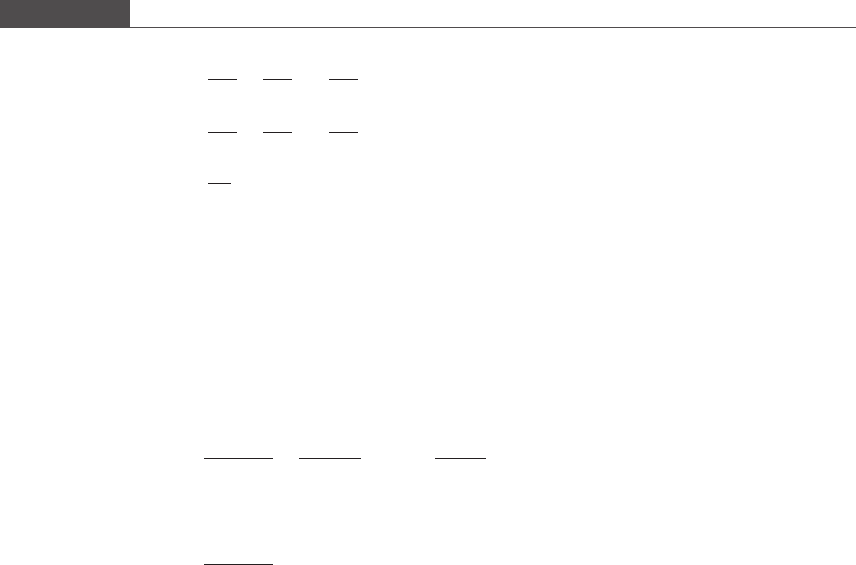
∂L
∂x
1
¼
∂f
∂x
1
þ l
∂h
∂x
1
¼ 0;
∂L
∂x
2
¼
∂f
∂x
2
þ l
∂h
∂x
2
¼ 0;
∂L
∂l
¼ hx
1
; x
2
ðÞ¼0:
For an objective function in n variables subjected to m equ ality constraints, the
Lagrangian function is given by
L x; lðÞ¼f xðÞþ
X
m
j¼1
l
j
h
j
ðxÞ; (8:15)
where l ¼ l
1
; l
2
; ...; l
m
½. The constrained optimization problem in n variables has
been converted to an unconstrained problem in n + m variables. For x* to be a critical
point of the constrained problem, it must satisfy the following n + m conditions:
∂Lðx; lÞ
∂x
i
¼
∂fðx; lÞ
∂x
i
þ
X
m
j¼1
l
j
∂h
j
ðxÞ
∂x
i
¼ 0; i ¼ 1; 2; ...; n;
and
∂Lðx; lÞ
∂l
j
¼ h
j
xðÞ¼0; j ¼ 1; 2; ...; m:
To find the optimum, one can solve either Equation (8.15) using unconstrained
optimization techniques discussed in Section 8.3 or the set of n + m equations
given by the necessary conditions. In other words, while the optimized parameters
of an uncon strained problem are obtained by solvi ng the set of equations given
by
rf ¼ 0 ;
for a constrained problem we must solve the augmented set of equations given by
r
L ¼ 0 ;
where
r
¼
r
x
r
l
:
How does one incorporate p inequality constraints into the optimization analysis?
This is done by converting the inequality constraints into equality constraints using
slack variab les:
g
k
xðÞþσ
2
k
¼ 0; k ¼ 1; 2; ...; p;
where σ
2
k
are called slack variables. The term is squared so that the slack variable
term will always be either equal to or greater than zero. If a slack variable σ
k
is zero at
any point x, then the kth inequality constraint is said to be active and x lies on the
boundary specified by the constraint g
k
xðÞ.Ifσ
k
6¼ 0, then the point x lies in the
interior of the boundary and g
k
xðÞis said to be an inactive inequality constraint. If p
inequality constraints are imposed on the objective function, one must add p
Lagrange multipliers to the set of variables to be optimized and p slack variables.
526
Nonlinear model regression and optimization
